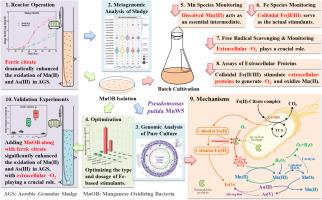当前位置:
X-MOL 学术
›
Water Res.
›
论文详情
Our official English website, www.x-mol.net, welcomes your
feedback! (Note: you will need to create a separate account there.)
Enhanced oxidation of Mn(II) and As(III) by aerobic granular sludge via ferrous citrate: Key roles of colloidal iron and extracellular superoxide radical
Water Research ( IF 11.4 ) Pub Date : 2024-10-28 , DOI: 10.1016/j.watres.2024.122705 Zhanfei He, Jingxun Gao, Qunqun Li, Zhen Wei, Daoyong Zhang, Xiangliang Pan
Water Research ( IF 11.4 ) Pub Date : 2024-10-28 , DOI: 10.1016/j.watres.2024.122705 Zhanfei He, Jingxun Gao, Qunqun Li, Zhen Wei, Daoyong Zhang, Xiangliang Pan

|
Microbial manganese (Mn) oxidation plays a crucial role in shaping the fate of various elements, including arsenic (As). However, this process faces challenges in wastewater environments due to its inherent inefficiency and instability. In our initial research, a serendipitous discovery occurred: the addition of citrate to Fe(II)-containing wastewater stimulated the oxidation of Mn(II) by aerobic granular sludge (AGS). Subsequent experiments in four sequencing batch reactors (SBRs) over a 67-day period confirmed this stimulatory effect. The presence of Fe(II)-citrate led to a remarkable twofold increase in the oxidation of Mn(II) and As(III). The removal efficiency improved from 21±4 % to 87±7 % for Mn(II) and from 77.1 ± 1.8 % to 93.6 ± 0.2 % for As(III). The verification experiments demonstrated that the simultaneous addition of manganese-oxidizing bacteria (MnOB) and Fe(II)-citrate is an effective strategy for enhancing the oxidation and removal of Mn(II) and As(III) by AGS. Through a combination of genomic analysis, cell-free filtrate incubation, and bacterial batch cultivations (including monitoring the time-course changes of 17 substances and 2 free radicals), we elucidated a novel Mn(II) oxidation pathway in Pseudomonas, along with its stimulation method and mechanism. First, bacteria rapidly degrade citrate possibly via the citrate-Mg2+:H+ symporter (CitMHS) and the tricarboxylic acid (TCA) cycle, resulting in the formation of colloidal Fe(II), colloidal Fe(III), and biogenic iron (hydr)oxides (FeOx). Then, colloidal Fe(II) and colloidal Fe(III) stimulated extracellular proteins to produce superoxide radicals (·O2−). These radicals were responsible for oxidizing Mn(II) into Mn(III), ultimately forming biogenic manganese oxides (MnOx). Finally, MnOx effectively oxidized As(III) to the less toxic As(V). This innovative approach for bacterial Mn(II) oxidation holds promise for treating Mn(II) and As(III) in water and wastewater. Furthermore, the mechanism by which colloidal iron stimulates extracellular proteins to produce ·O2−, thereby facilitating Mn(II) oxidation, may widely occur across various engineering and natural ecosystems.
中文翻译:

通过柠檬酸亚铁的好氧颗粒污泥对 Mn(II) 和 As(III) 的增强氧化:胶体铁和细胞外超氧自由基的关键作用
微生物锰 (Mn) 氧化在塑造包括砷 (As) 在内的各种元素的命运中起着至关重要的作用。然而,由于其固有的低效率和不稳定性,该工艺在废水环境中面临挑战。在我们的初步研究中,偶然发现:在含 Fe(II) 的废水中添加柠檬酸盐刺激了好氧颗粒污泥 (AGS) 对 Mn(II) 的氧化。随后在 4 个序批式反应器 (SBR) 中进行了 67 天的实验,证实了这种刺激作用。Fe(II)-柠檬酸盐的存在导致 Mn(II) 和 As(III) 的氧化显着增加两倍。Mn(II) 的去除效率从 21±4 % 提高到 87±7 %,As(III) 的去除效率从 77.1 ± 1.8 % 提高到 93.6 ± 0.2 %。验证实验表明,同时添加锰氧化菌 (MnOB) 和 Fe(II)-柠檬酸盐是增强 AGS 氧化和去除 Mn(II) 和 As(III) 的有效策略。通过基因组分析、无细胞滤液孵育和细菌批量培养(包括监测 17 种物质和 2 种自由基的时程变化)的组合,我们阐明了假单胞菌中一种新的 Mn(II) 氧化途径,以及其刺激方法和机制。首先,细菌可能通过柠檬酸盐-Mg2+:H+ 同向转运蛋白 (CitMHS) 和三羧酸 (TCA) 循环快速降解柠檬酸盐,从而形成胶体 Fe(II)、胶体 Fe(III) 和生物铁(氢)氧化物 (FeOx)。然后,胶体 Fe(II) 和胶体 Fe(III) 刺激细胞外蛋白产生超氧自由基 (·O2−)。 这些自由基负责将 Mn(II) 氧化成 Mn(III),最终形成生物成因氧化锰 (MnOx)。最后,MnOx 有效地将 As(III) 氧化成毒性较小的 As(V)。这种用于细菌 Mn(II) 氧化的创新方法有望处理水和废水中的 Mn(II) 和 As(III)。此外,胶体铁刺激细胞外蛋白产生 ·O2−,从而促进 Mn(II) 氧化,可能广泛存在于各种工程和自然生态系统中。
更新日期:2024-10-31
中文翻译:

通过柠檬酸亚铁的好氧颗粒污泥对 Mn(II) 和 As(III) 的增强氧化:胶体铁和细胞外超氧自由基的关键作用
微生物锰 (Mn) 氧化在塑造包括砷 (As) 在内的各种元素的命运中起着至关重要的作用。然而,由于其固有的低效率和不稳定性,该工艺在废水环境中面临挑战。在我们的初步研究中,偶然发现:在含 Fe(II) 的废水中添加柠檬酸盐刺激了好氧颗粒污泥 (AGS) 对 Mn(II) 的氧化。随后在 4 个序批式反应器 (SBR) 中进行了 67 天的实验,证实了这种刺激作用。Fe(II)-柠檬酸盐的存在导致 Mn(II) 和 As(III) 的氧化显着增加两倍。Mn(II) 的去除效率从 21±4 % 提高到 87±7 %,As(III) 的去除效率从 77.1 ± 1.8 % 提高到 93.6 ± 0.2 %。验证实验表明,同时添加锰氧化菌 (MnOB) 和 Fe(II)-柠檬酸盐是增强 AGS 氧化和去除 Mn(II) 和 As(III) 的有效策略。通过基因组分析、无细胞滤液孵育和细菌批量培养(包括监测 17 种物质和 2 种自由基的时程变化)的组合,我们阐明了假单胞菌中一种新的 Mn(II) 氧化途径,以及其刺激方法和机制。首先,细菌可能通过柠檬酸盐-Mg2+:H+ 同向转运蛋白 (CitMHS) 和三羧酸 (TCA) 循环快速降解柠檬酸盐,从而形成胶体 Fe(II)、胶体 Fe(III) 和生物铁(氢)氧化物 (FeOx)。然后,胶体 Fe(II) 和胶体 Fe(III) 刺激细胞外蛋白产生超氧自由基 (·O2−)。 这些自由基负责将 Mn(II) 氧化成 Mn(III),最终形成生物成因氧化锰 (MnOx)。最后,MnOx 有效地将 As(III) 氧化成毒性较小的 As(V)。这种用于细菌 Mn(II) 氧化的创新方法有望处理水和废水中的 Mn(II) 和 As(III)。此外,胶体铁刺激细胞外蛋白产生 ·O2−,从而促进 Mn(II) 氧化,可能广泛存在于各种工程和自然生态系统中。


















































 京公网安备 11010802027423号
京公网安备 11010802027423号